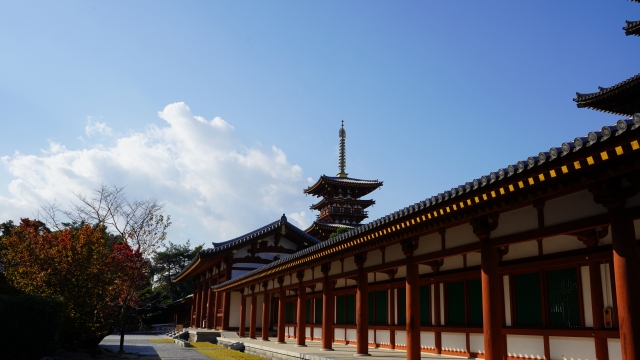About Nara Yakushiji Temple
Inside the Yakushi-ji Temple is a beautiful statue of Yakushi Nyorai, accompanied by the Bodhisattva of Sunlight and Moonlight. The Yakushi Nyorai throne is decorated with beautiful carvings of the Four Sacred Beasts, as well as Greek grapes, Tang grass patterns, Persian lotus patterns, and statues of Indian power gods.
Yakushiji Temple is also worth seeing the East Pagoda, one of the only remaining representatives of the White Phoenix culture, but due to maintenance work, it was not possible to see it.
The west pagoda is a five-fold pagoda, and the east pagoda is a three-fold pagoda, where exhibitions are held from time to time.

How to get there
5 minutes walk from “Nishinokyo Station”;
From “Nara Station” or “Kintetsu Nara Station” take bus “No. 70 or No. 72” to “Yakushiji” and get off at 5 minutes walk.
Fare
Adult:1,100 yen
Middle school students:700 yen
Elementary school students: 300 yen
Combined ticket (Shirahoga Garan, Genzo Sanzoin Garan, West Tower, and Dining Hall)
Adult: 1,600 yen
Junior high school students: 1,200 yen
Elementary school students: 300 yen
Tips
Yakushiji Temple, the main mountain of the Hosho sect (also a World Heritage Site and one of the Seven Great Temples of Nanto). One of the important buildings is the East Pagoda, which was built in the Nara period and is the only surviving structure of Yakushiji Temple from the time of its creation.
Yakushi-ji Temple was built even earlier, and it is possible that the East Pagoda was built in the Shirahome period, from 680 to 697. However, the East Tower has been disassembled and repaired since Heisei 21 and is scheduled to be completed in Heisei 32 (2020).
The restoration of the other buildings, the Golden Hall, was completed in 1976, and the West Tower was restored in 1956. The Nakamado Lecture Hall was also restored during the Showa period, and all of them were restored with traditional craftsmanship in the present day. Other ancient buildings that exist are the Toinendo, Kamakura period. Minamimon is from the Muromachi period. Wakamisha shrine temple, late Kamakura period.
Hachiman Shrine shrine temple (three buildings), Momoyama period. Although there are not many original buildings left in Yakushiji Temple, there are national treasures in all the halls. For example, the Avalokiteshvara statue in the East Temple. I don’t know much about the history and introduction of Yakushiji Temple because this temple is a native Japanese Buddhist temple and has little connection with China. All I know is that the East Pagoda has an indelible place in the history of Japanese architecture (although I didn’t see it this time).
This temple also has a branch in memory of Xuanzang, with a plaque engraved on it that reads “BUTO”, which is probably the origin of this temple and China, because of the relationship between the Hosho sect and the monk Xuanzang of the Tang Dynasty, but this temple was founded much longer ago, by the wish of Emperor Seibu.
Passing by a path to know that a thousand years ago, this is not the countryside, but a bustling downtown, the sea has changed for more than a thousand years, the farmland has replaced the city, the temple from the previous bustling square city to the present quiet and secluded countryside. The water is clear, the village is clean, and the rice paddies exude a charming atmosphere unique to the fields. When I arrived at Yakushiji Temple, it was already closed, so I could only pat the gate to express my worries.
The Tang culture is like the red apricot that stretches out of the courtyard, which is beautiful in other courtyards but dark in itself.